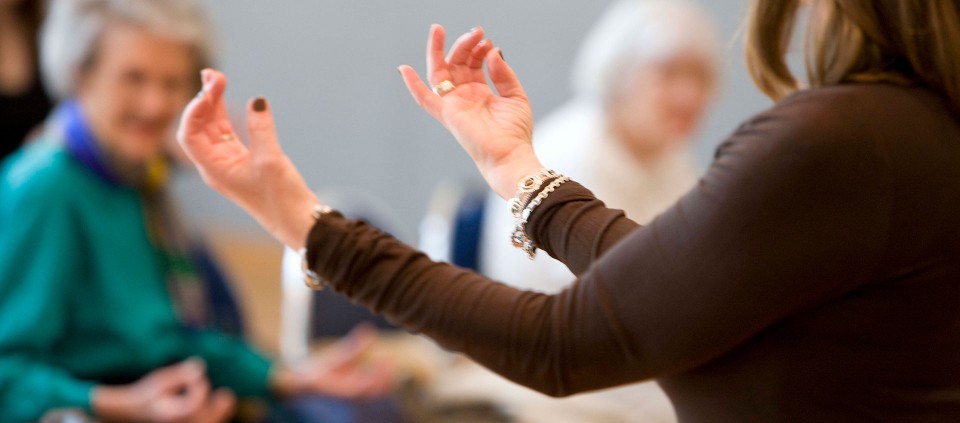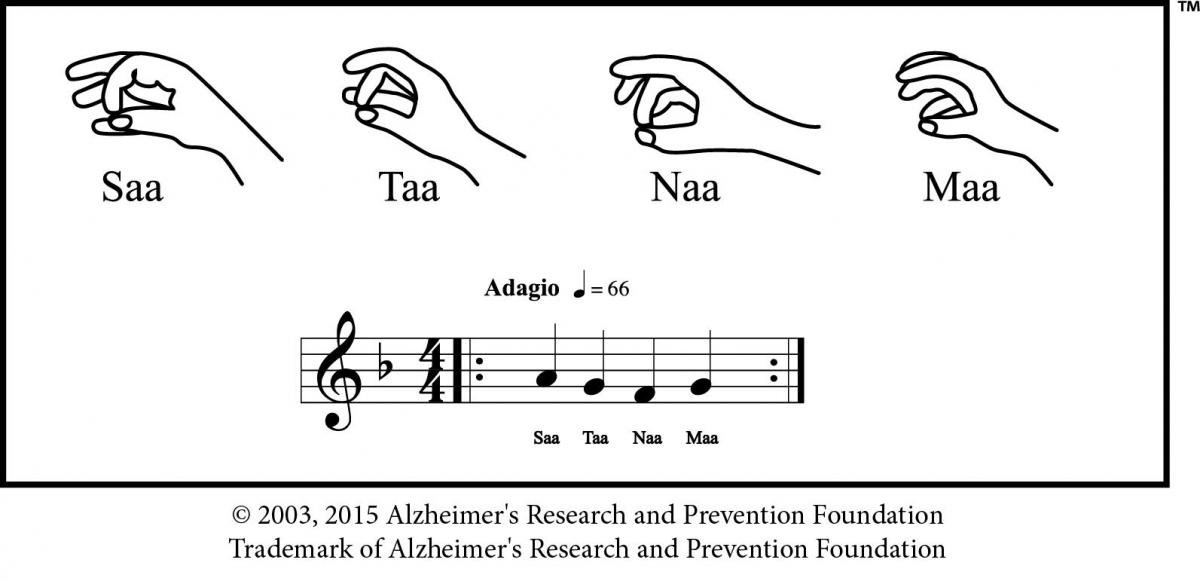The Incredible Power of Kirtan Kriya: A Conversation on Brain Health and Longevity with Dr. Chris Walling

Imagine that you could do just 12 minutes of yoga practice every day—and live longer, stay healthier, feel happier, and think more clearly. You’d do it, right?
If you answered yes, then get started right now. According to clinical psychologist and yoga therapist Chris Walling, doing 12 minutes daily of the Kundalini Yoga practice known as Kirtan Kriya is proven to enhance brain and mental health, increase longevity, and keep your mind sharp.
“Not only can this protocol help people live longer and better, it also can also alleviate a lot of chronic illnesses,” Chris says. “People who do this practice are buying themselves quite a few years on the tail end.”
A Multisensory Intervention
Chris describes Kirtan Kriya as a “multisensory intervention,” combining breath, mudra (finger movements), mantra, and visualization to create far-reaching effects. Its benefits for health and longevity have long been recognized within the Kundalini Yoga lineage, but Kundalini master Yogi Bhajan and his student Dharma Singh Khalsa, MD (cofounder with Kirti Khalsa of the Alzheimer’s Research and Prevention Foundation) set the stage for ongoing scientific inquiry into the nature and impact of this powerful practice.
“Once it was investigated from the clinical angle, researchers discovered a whole host of brain health–supporting features,” says Chris. “Through the last couple of decades, research at top-tier academic research hospitals and institutions in the United States and all over the world have discovered that this kriya, when practiced regularly over a period of eight weeks, begins to improve a whole range of measures, from cognitive performance on memory testing all the way to cellular changes.”
A groundbreaking study at the University of California Los Angeles (UCLA), where Chris was executive administrator for the university’s Longevity Center, showed that regular practice increased telomerase—the enzyme linked to structures at the ends of our chromosomes, which affect how our cells age. In fact, telomerase was increased by 43 percent, the largest increase ever recorded. Other studies on the practice have shown that it improves blood flow to the brain, reverses memory loss, eases depression and decreases inflammatory genes while increasing healthy ones.
Research like this makes it clear that Kirtan Kriya can be a potent approach to preventing Alzheimer’s disease, as well as geriatric depression, which often resembles Alzheimer’s in its symptoms, says Chris, who serves as chairman of the Alzheimer’s Research and Prevention Foundation’s Education Advisory Committee. Within a few weeks of beginning a Kirtan Kriya practice, he says, people turn around—suddenly shaking off brain fog and forgetfulness.
How does it work? Chris says the amazing benefits of the practice can be explained in part by the fact that it stimulates and connects different areas of the brain. “We’re gradually unlocking the neurobiology of the practice using neuroimaging technology, so that we can understand how something so simple can be so powerful,” he says.
The Foundation has distilled the research on longevity and brain health into four pillars of Alzheimer’s prevention: diet and nutrition; physical and mental exercise; stress management using yoga and meditation; and “spiritual fitness”—what Chris describes as psycho-spiritual well-being. “We’ve taken these four cornerstones and created a comprehensive, evidence-based program that people that can deliver in their classrooms and to their communities,” he says.
Brain Longevity Training for Professionals
Last fall at UCLA, the Foundation delivered its first comprehensive Brain Longevity Yoga Therapy Training to a group of 50 yoga teachers, yoga therapists, nurses, psychotherapists, dietitians, physical and occupational therapists, and other healthcare and wellness professionals. The training was broadcast live, with participants in Germany, Italy, the Czech Republic, and Australia.
“What they all shared was a serious ambition to help people live better, longer,” Chris says. “We know the data and statistics—we are an aging population and we have limited resources available for the aging. We need to find other ways to provide support and services. Yoga therapy is an ancient solution, delivered in a modern way, for serious mental and physical health problems. It’s a movement that’s going to change the landscape of how we treat aging.”
Kripalu is the site for the second iteration of the Brain Health Longevity Training, which synthesizes the research as well as the practical yoga therapy applications. Participants receive a comprehensive manual, a workbook with sequences, and a PowerPoint deck with a full teaching script.
“It’s designed to be super user-friendly,” Chris says. “If people walked away with no additional training and just the materials from the course, they could immediately teach themselves how to deliver this protocol.”
Tools, Not Schools
Chris was first exposed to yoga therapy while overseeing a study at UCLA on the impact of Kirtan Kriya on the depression and anxiety scales of a group of caregivers. “I was a stressed-out healthcare executive, and I became a practitioner of the very yoga I was administering the research for,” he recalls. “I came to yoga with the impulse to get healthier. I had no particular agenda, but it very quickly took over my entire life. It became a serious passion almost overnight.”
He studied with Kundalini teachers in New York City, Sweden, and India, as well as at home in California, eventually completing 800 hours of yoga teacher and yoga therapist training. Then he went back to school for his doctorate in psychology, delving into the processes through which the mind-body connection influences disease and mental health. (He is currently president of the United States Association of Body Psychotherapy.)
In examining the healing potential of yoga through various lenses, Chris has come to believe that the therapeutic applications of Kirtan Kriya and similar interventions transcend any one lineage or approach.
“I believe in tools, not schools,” he says. “These are non-dogmatic practices that don’t require joining a dharma or religion—they just require that you carve out some time for your health. Yoga is a mental hygiene practice—just as you brush your teeth every day, you can do yoga every day.”
How to Do Kirtan Kriya
from the Alzheimer’s Research and Prevention Foundation
Posture: Sit comfortably in a chair with your feet flat on the floor. Alternatively, you can sit on the floor with your legs crossed, although older adults are not likely to choose this option. The essence of the posture is to be comfortable and sit with the spine straight with only the natural curvature.
Breath: Breathe naturally as the meditation unfolds.
Eyes: The eyes are closed.
The Chant, or Mantra: The chant uses the sounds, Saa, Taa, Naa, Maa. These ancient sounds taken together mean “my true identity” or “my highest self.” The tune to which these sounds are sung is the first four notes of the familiar children’s song, “Mary had a Little Lamb.” That is, the notes are “Mar-y had a.”
The Mudras, or Finger Movements: The thumb is touched to each of the other four fingers in sequence. Both hands perform the same mudra set simultaneously.
- On Saa, touch the index fingers of each hand to the thumbs.
- On Taa, touch your middle fingers to your thumbs.
- On Naa, touch your ring fingers to your thumbs.
- On Maa, touch your little fingers to your thumbs.
Always go forward in sequence: thumb to index finger, middle finger, ring finger, and pinky; never go backwards.
The Visualization: Visualize energy coming down from above into the middle of the top of the head, proceeding straight down into your brain, and then changing to a lateral direction so that it comes out of your head at a point in the middle of your forehead in the center, lined up with the nose (the spot referred to as “the third eye” in some Eastern traditions). Hence, the energy is visualized as following the path of a capital letter “L.” One may think of this action as sweeping through like a broom.
The Sequence: Sing the sounds Saa Taa Naa Maa while also performing the mudras with the fingers of both hands. At the same time, visualize the sound flowing in through the top of your head and out the middle of your forehead in an L shape.
- For two minutes, sing out loud.
- For the next two minutes, use a stage whisper.
- For the next four minutes, say the sound silently to yourself.
- Then whisper the sounds for two minutes and then out loud for two minutes, for a total of 12 minutes.
To come out of the exercise, inhale very deeply, stretch your hands above your head, and then bring them down slowly in a sweeping motion as you exhale.

